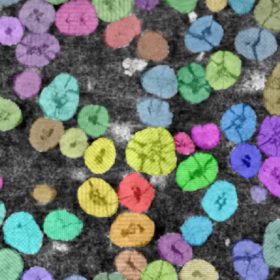
Scientists at the SLAC National Accelerator Laboratory in the U.S. have developed a machine learning algorithm that can identify and track individual particles within a lithium-ion battery cell. Their findings shed more light on how the batteries lose performance over time, and could challenge previous assumptions of scientists working to develop batteries with longer lifetimes.
Performance loss over time is one of several problems common to today’s lithium-ion battery technologies. Though second life markets are developing for batteries that have suffered degradation after several years in operation, eliminating this effect is a focus for scientists around the world, and many different approaches exist.
Before the problem can be solved, however, it needs to be well understood. With this in mind, scientists at the U.S. Department of Energy’s SLAC Accelerator Laboratory in California used x-ray techniques to get a better look at particle interactions within the cathode of a working lithium-ion battery.
The group worked on the theory that NMC particles breaking away from the cathode could be a cause of performance degradation. They were able to confirm this, and visualize the mechanism in action using a process called quantitative X-ray phase-contrast nano-tomography, carried out at two synchrotron light source facilities – SLAC’s own Stanford Synchrotron Radiation Lightsource, and the European Synchrotron Facility in France.
Computer vision
The scientists describe the process of manually identifying each individual particle in the x-ray images as “tedious and labor-intensive”, and so looked to machine learning techniques to speed up and automate this process. Using an approach known as computer vision, often used in object tracking and identification applications, the group was able to ‘train’ an algorithm to distinguish different particle types and ultimately develop an image of how NMC particles break away from the cathode, causing performance loss.
With this approach they were able to confirm that, in during operation in consumer electronics, particles breaking away from the cathode do contribute to performance loss. The results of this combined approach are published in Nature Communications, in the paper Machine-learning-revealed statistics of the particle-carbon/binder detachment in lithium-ion battery cathodes.
The scientists also observed that small as well as large particles often break away, and small particles do not behave uniformly – something that may influence future research in the field. “Researchers had generally assumed that by making battery particles smaller, they could make longer-lasting batteries,” explains SLAC staff scientist Yijin Liu. “[This is] something the new study suggests might not be so straightforward.”
Lắp đặt điện mặt trời Khải Minh Tech
https://ift.tt/2X7bF6x
0906633505
info.khaiminhtech@gmail.com
80/39 Trần Quang Diệu, Phường 14, Quận 3
Lắp đặt điện mặt trời Khải Minh Tech
https://ift.tt/2ZH4TRU
Không có nhận xét nào:
Đăng nhận xét